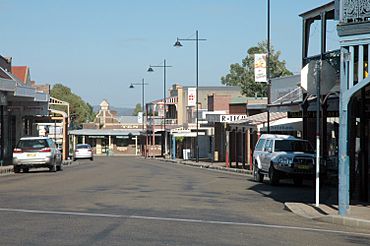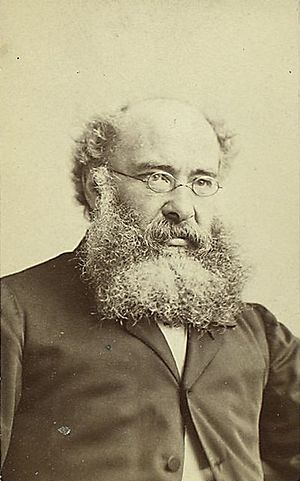Gulgong facts for kids
Quick facts for kids GulgongNew South Wales |
|||||||||
|---|---|---|---|---|---|---|---|---|---|

Mayne Street
|
|||||||||
| Postcode(s) | 2852 | ||||||||
| Elevation | 475 m (1,558 ft) | ||||||||
| Location | |||||||||
| LGA(s) | Mid-Western Regional Council | ||||||||
| County | Phillip | ||||||||
| State electorate(s) | Dubbo | ||||||||
| Federal Division(s) | Parkes | ||||||||
|
|||||||||
Gulgong is a historic town in New South Wales, Australia. It is located in the Central Tablelands region. This area is known as the Central West. Gulgong is about 300 kilometers (186 miles) north-west of Sydney. It is also about 30 kilometers (19 miles) north of Mudgee.
In 2021, Gulgong had a population of 2,680 people. The town still looks much like it did in the 1800s. This makes it a popular place for tourists to visit. A special place to see is the Prince of Wales Opera House. It has a long and interesting history.
Another great spot is the Gulgong Pioneer Museum. It has many old items on display. You can see everything from kitchen tools to entire buildings. These buildings were moved to the museum site. Besides tourism, Gulgong is known for making wine. It also produces wool, grows wheat, and has coal mines.
Yarrobil National Park is a natural area near Gulgong. It is about 21 kilometers (13 miles) north-west of the town.
Contents
Discovering Gulgong's Past
The name 'Gulgong' comes from the Wiradjuri people. They are the traditional inhabitants of this land. The name means 'deep waterhole'. Gulgong started as a gold mining town in the 1870s. It was one of the last places where many people searched for gold on their own. These were called 'poor man's diggings'. This meant miners did not need a lot of money to start.
Famous Writers and Gulgong
The famous Australian writer Henry Lawson lived in Gulgong as a child. This was in the early 1870s. His father was a gold miner here. Pictures of Gulgong from the gold rush era were even on the first Australian ten dollar note! Lawson wrote about Gulgong in his stories.
Another important writer, Thomas Alexander Browne, also lived in Gulgong. He was a police magistrate from 1871 to 1881. He once hosted the English author Anthony Trollope. Trollope later wrote about his travels in Australia. Gulgong is also thought to be a main setting in Browne's book Robbery under Arms.
Gulgong's Railway Connections
Gulgong once had a busy railway station. It was a meeting point for two railway lines. One line, the Sandy Hollow line, comes from Muswellbrook. The other, the Gwabegar line, runs north and south. Part of the Gwabegar line south of Gulgong has been closed since 2007.
Local Events and Festivals
Gulgong often hosts different events and festivals. These include both local gatherings and bigger international events.
Notable People from Gulgong
Many interesting people have connections to Gulgong:
- Jimmy Governor grew up in the Gulgong area.
- Nancy Hill (born 1934) is an Australian basketball player.
- Josh Jackson is a rugby league player.
- Louisa Lawson was a poet and the mother of Henry Lawson.
- Colin McKellar was an Australian senator.
- Michaeley O'Brien is an Australian screenwriter.
Images for kids













